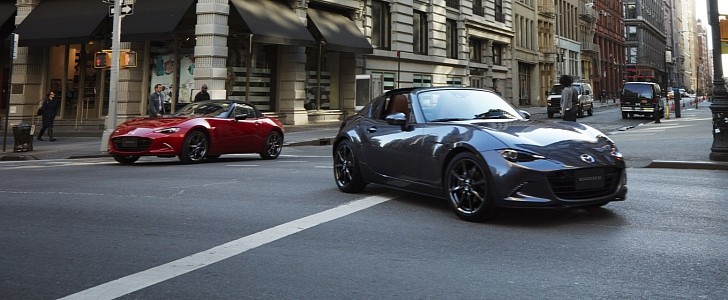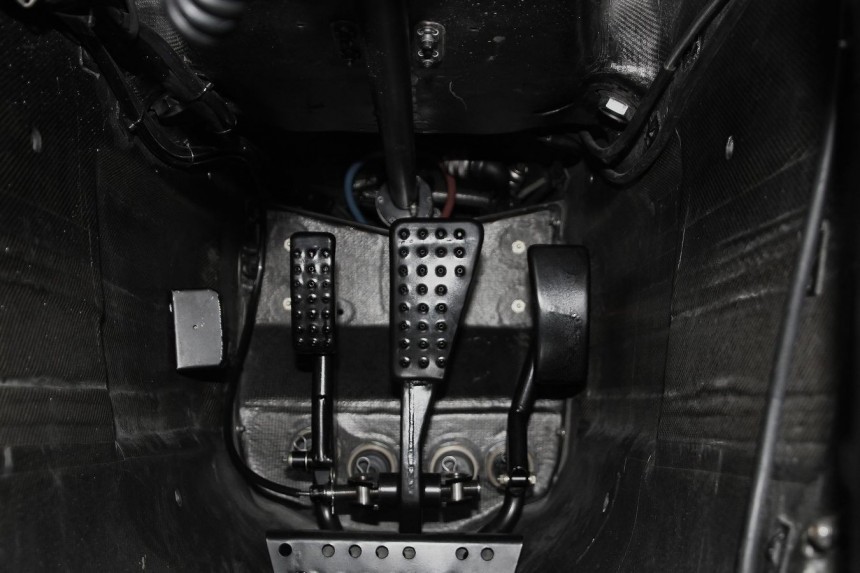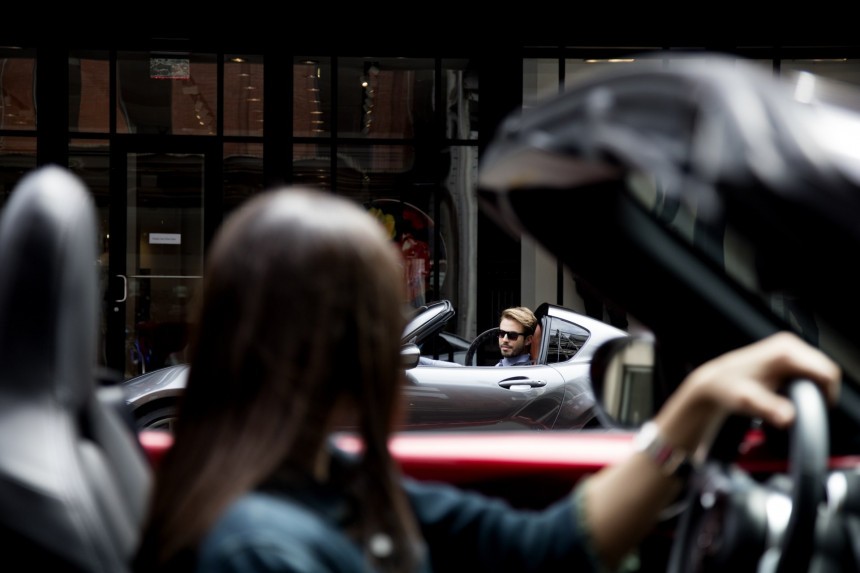The 2022 Mazda MX-5 will come as standard with a new technology called Kinematic Posture Control. You already know this if you follow autoevolution, but I am sure few have thought about Formula 1 when this technology was described. Confused? We will explain in the following lines.
Back in 1997, McLaren and Ferrari were battling it out in the Formula 1 championship for the top spot. What was not known then was that the team from Woking developed a system that it called “brake-steer,” and it was done with about GBP 50 (ca. $66) worth of parts that they already had in the back of one of their racecar transporters.
Sounds like a story that was sewn with a very thin thread, but it all started with an idea that popped up in Steve Nichols' mind over the 1996 winter break. He was a veteran chief engineer at McLaren, and he figured out that braking just one rear tire during a corner could reduce understeer, which would be dialed-in to the race cars of the time.
With what was later dubbed “fiddle-brake” by other teams, but “brake-steer” within McLaren, the driver would be able to apply the brake on just one of the rear wheels, the one on the inside of the corner, while also pressing the gas. The brake application would usually happen mid-corner, but the driver would do the work.
As McLaren later explained, the driver could balance out understeer in slower corners and put a yaw moment on the race car, while faster corners that still had understeer were overcome with rear brake and more throttle. In Mika Häkkinen's first test of the new technology at Silverstone in 1997, he gained “nearly half a second per lap.”
Half a second per lap with minimal investment, rule compliance, and just a bit more driver effort? That sounds like magic, right? The car proved fast, and the team eventually improved the technology to allow the driver to select the wheel that would get the input on the fly.
Why? The first version of the system involved choosing the wheel that would work with the system, and it had an extra brake master cylinder and a dedicated brake line to allow its operation. Later, two brake cylinders were fitted, but the driver had to switch between them manually.
David Coulthard, who first refused to use the system due to being uncomfortable with left-foot braking, quickly adapted to it after he discovered its use.
Coulthard recalled that he and Mika Häkkinen figured out that they can control the wheel-spin as they come out of slow corners with the “fiddle-pedal,” as well as the fact that the system would provide a yaw-moment on the car, thus reducing necessary steering input to turn the car.
While other teams accused McLaren of cheating, even four-wheel-steering being considered as the real reason for the speed advantage of the team, the extra brake pedal was compliant with regulations of the 1997 season, and it only got banned during the 1998 season.
The system would not have been compliant with FIA regulations if it had automatically selected what wheel would get brake pressure, but the drivers had a switch on the wheel for that, which is why it did not get banned from the first attempts.
The ban arrived on the basis of an existing one that targets four-wheel steering, even though the system was not steering the rear wheels, but the FIA linked the ban to the “brake-steer” name.
That is when Ross Brawn used the “fiddle-brake” term, which already existed in cross-country trial vehicles that had a handbrake that worked on each of the rear wheels to turn the car.
Now, Mazda's technology did not receive an explanation that provides excessive detail. We do know that the driver does not have to do anything else to activate the technology, and that there is no extra pedal to individually activate the brake on one of the rear wheels.
If McLaren had attempted to use a system just like Mazda's KPC, it would have not been allowed to, as it was against the regulations of the time. Fortunately, there is nobody to ban the use of the system on the road or on track days, as it is entirely automatic in operation. We do not know if it will bring up to half a second per lap on a track day, though. But the potential is there.
If Mika Häkkinen got almost half a second per lap in an F1 race car with the technology working just on one wheel, Mazda's tech is significantly more advanced, as it can work either rear wheel, and it “knows” exactly how much pressure is needed, when it is needed, and when it is not required.
As Mazda underlined, the system does not bring added weight. Evidently, it works by applying the brake using the built-in systems of the vehicle, such as the ABS, ESC, and traction control.
Out of the latter two, either can brake just one wheel in a vehicle. And the system can work faster than a human, with immense precision as well, and it may be imperceptible in operation. Sound brilliant, right?
It is brilliant, and the best part is that other manufacturers could adopt the technology. The downside is that it may bring additional wear to the rear pads and calipers, but do not imagine that the system will get them glowing hot as it happened with McLaren's 1997 race car and tipped the attention of F1 photographer Danner Heath, who discussed the matter with editor Matt Bishop in search of an explanation.
While nobody in the world (except for Mazda engineers) has had the time to experiment with the system, we think it will not generate immense wear to the rear pads or the rear discs, as it only works in minute applications in high-speed corners, which come with higher G forces.
Worrying about any wear from this system would be like worrying about wear from the traction control system or ESC system being engaged. It is the same thing, and it works with the same tools.
We hope that this will lead to a comparison test between a 2021 Mazda MX-5 and a 2022 Mazda MX-5, with the same kind of tire and the same driver behind the wheel. Those who want to get all scientific could fit fresh brake pads and measure their wear after prolonged use. Do not expect a major difference, though.
Sounds like a story that was sewn with a very thin thread, but it all started with an idea that popped up in Steve Nichols' mind over the 1996 winter break. He was a veteran chief engineer at McLaren, and he figured out that braking just one rear tire during a corner could reduce understeer, which would be dialed-in to the race cars of the time.
With what was later dubbed “fiddle-brake” by other teams, but “brake-steer” within McLaren, the driver would be able to apply the brake on just one of the rear wheels, the one on the inside of the corner, while also pressing the gas. The brake application would usually happen mid-corner, but the driver would do the work.
As McLaren later explained, the driver could balance out understeer in slower corners and put a yaw moment on the race car, while faster corners that still had understeer were overcome with rear brake and more throttle. In Mika Häkkinen's first test of the new technology at Silverstone in 1997, he gained “nearly half a second per lap.”
Half a second per lap with minimal investment, rule compliance, and just a bit more driver effort? That sounds like magic, right? The car proved fast, and the team eventually improved the technology to allow the driver to select the wheel that would get the input on the fly.
Why? The first version of the system involved choosing the wheel that would work with the system, and it had an extra brake master cylinder and a dedicated brake line to allow its operation. Later, two brake cylinders were fitted, but the driver had to switch between them manually.
David Coulthard, who first refused to use the system due to being uncomfortable with left-foot braking, quickly adapted to it after he discovered its use.
While other teams accused McLaren of cheating, even four-wheel-steering being considered as the real reason for the speed advantage of the team, the extra brake pedal was compliant with regulations of the 1997 season, and it only got banned during the 1998 season.
The system would not have been compliant with FIA regulations if it had automatically selected what wheel would get brake pressure, but the drivers had a switch on the wheel for that, which is why it did not get banned from the first attempts.
The ban arrived on the basis of an existing one that targets four-wheel steering, even though the system was not steering the rear wheels, but the FIA linked the ban to the “brake-steer” name.
That is when Ross Brawn used the “fiddle-brake” term, which already existed in cross-country trial vehicles that had a handbrake that worked on each of the rear wheels to turn the car.
Now, Mazda's technology did not receive an explanation that provides excessive detail. We do know that the driver does not have to do anything else to activate the technology, and that there is no extra pedal to individually activate the brake on one of the rear wheels.
If Mika Häkkinen got almost half a second per lap in an F1 race car with the technology working just on one wheel, Mazda's tech is significantly more advanced, as it can work either rear wheel, and it “knows” exactly how much pressure is needed, when it is needed, and when it is not required.
As Mazda underlined, the system does not bring added weight. Evidently, it works by applying the brake using the built-in systems of the vehicle, such as the ABS, ESC, and traction control.
Out of the latter two, either can brake just one wheel in a vehicle. And the system can work faster than a human, with immense precision as well, and it may be imperceptible in operation. Sound brilliant, right?
It is brilliant, and the best part is that other manufacturers could adopt the technology. The downside is that it may bring additional wear to the rear pads and calipers, but do not imagine that the system will get them glowing hot as it happened with McLaren's 1997 race car and tipped the attention of F1 photographer Danner Heath, who discussed the matter with editor Matt Bishop in search of an explanation.
While nobody in the world (except for Mazda engineers) has had the time to experiment with the system, we think it will not generate immense wear to the rear pads or the rear discs, as it only works in minute applications in high-speed corners, which come with higher G forces.
Worrying about any wear from this system would be like worrying about wear from the traction control system or ESC system being engaged. It is the same thing, and it works with the same tools.
We hope that this will lead to a comparison test between a 2021 Mazda MX-5 and a 2022 Mazda MX-5, with the same kind of tire and the same driver behind the wheel. Those who want to get all scientific could fit fresh brake pads and measure their wear after prolonged use. Do not expect a major difference, though.











